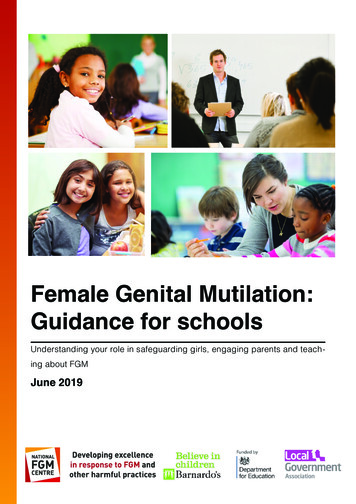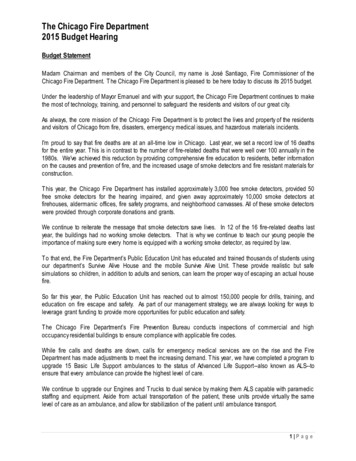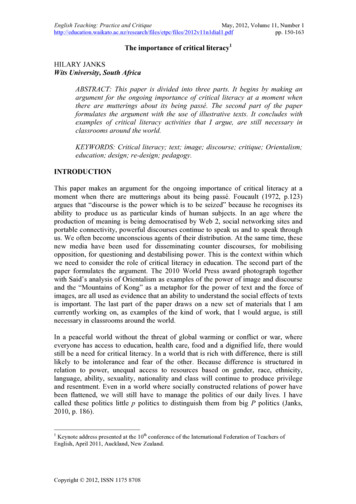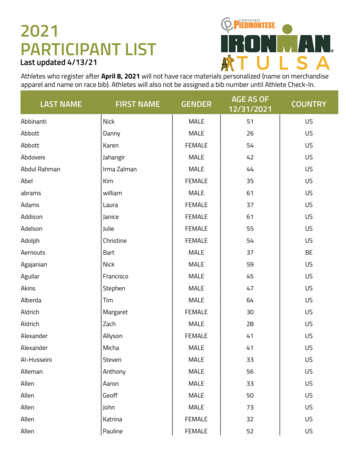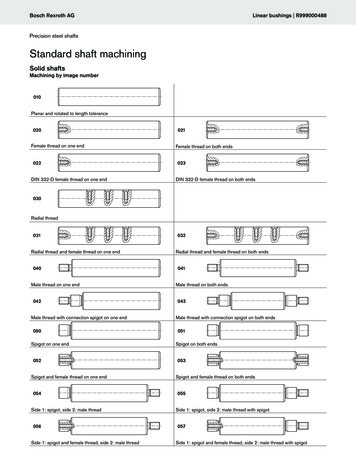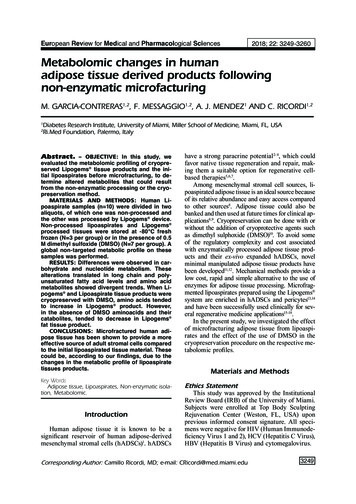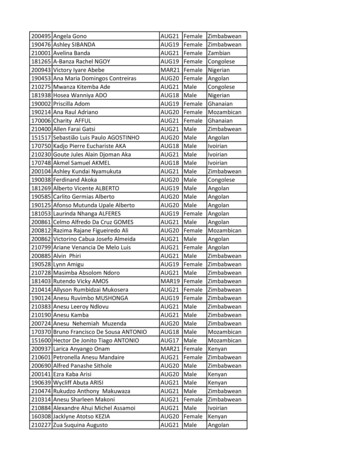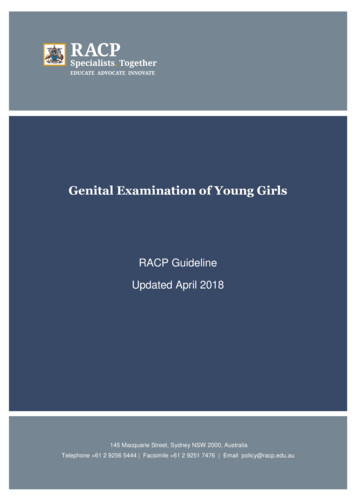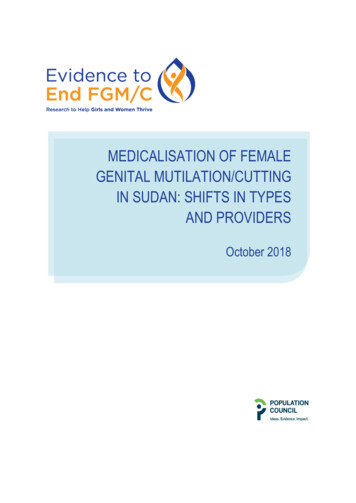
Transcription
MEDICALISATION OF FEMALEGENITAL MUTILATION/CUTTINGIN SUDAN: SHIFTS IN TYPESAND PROVIDERSOctober 2018
MEDICALISATION OF FEMALEGENITAL MUTILATION/CUTTINGIN SUDAN: SHIFTS IN TYPESAND PROVIDERSNAFISA BEDRIHUDA SHERFIGHADA RODWANSARA ELHADIWAFA ELAMINGENDER AND REPRODUCTIVE HEALTH ANDRIGHTS RESOURCE AND ADVOCACY CENTERAHFAD UNIVERSITY FOR WOMENOCTOBER 2018
The Evidence to End FGM/C: Research to Help Girls and Women Thrive generates evidence to inform and influenceinvestments, policies, and programmes for ending female genital mutilation/cutting in different contexts. Evidence toEnd FGM/C is led by the Population Council, Nairobi in partnership with the Africa Coordinating Centre for the Abandonmentof Female Genital Mutilation/Cutting (ACCAF), Kenya; the Gender and Reproductive Health and Rights Resource andAdvocacy Center (GRACE), Sudan; the Global Research and Advocacy Group (GRAG), Senegal; Population Council, Nigeria;Population Council, Egypt; Population Council, Ethiopia; MannionDaniels, Ltd. (MD); Population Reference Bureau (PRB);University of California, San Diego (Dr. Gerry Mackie); and University of Washington, Seattle (Prof. Bettina Shell-Duncan).The Population Council confronts critical health and development issues—from stopping thespread of HIV to improving reproductive health and ensuring that young people lead full andproductive lives. Through biomedical, social science, and public health research in 50 countries,we work with our partners to deliver solutions that lead to more effective policies, programmes,and technologies that improve lives around the world. Established in 1952 and headquarteredin New York, the Council is a nongovernmental, nonprofit organisation governed by aninternational board of trustees. www.popcouncil.orgGRACe is a leading regional center of excellence on gender and reproductive health and rights;Providing quality resources for all stakeholders, building capacities, promoting evidence-basedplanning and policy for empowering women and men and promoting reproductive health as afundamental human right for all. GRACe values are gender equality, women empowerment,integrity, respect for human rights and excellence. It aims to promote gender equality andreproductive health and rights of the community in general and of women in Sudan and theregion. www.grace.ahfad.edu.sdSuggested Citation: Bedri, N., Sherfi, H., Rodwan, G., Elhadi, S., and Elamin, W. 2018. Medicalisation of Female GenitalMutilation/Cutting in Sudan: Shift in Types and Providers. Evidence to End FGM/C: Research to Help Girls and WomenThrive. New York: Population Council.This is a working paper and represents research in progress. This paper represents the opinions of the authors and is theproduct of professional research. This paper has not been peer reviewed, and this version may be updated with additionalanalyses in subsequent publications. Contact: Prof Nafisa Bedri, nmbedri@gmail.comPlease address any inquiries about the Evidence to End FGM/C programme consortium to:Dr Jacinta Muteshi, Project Director, jmuteshi@popcouncil.orgFunded by:This document is an output from a programme funded by the UK Aid from the UK government for the benefit of developingcountries. However, the views expressed and information contained in it are not necessarily those of, or endorsed by the UKgovernment, which can accept no responsibility for such views or information or for any reliance placed on them.
Table of ContentsList of Acronyms. iiiAcknowledgments . ivExecutive Summary . vIntroduction .1Background . 1Female Genital Mutilation/Cutting in Sudan . 2The Sudanese Health System . 4Study Aims and Objectives .4Theoretical Framework .5Methods.7Study Design. 7Study Population . 7Sample Size and Sampling . 7Data Collection Procedures . 8Data Analysis . 8Ethical Considerations . 9Results .9Household Survey Results . 9Perceived Reasons why FGM/C Continues to be Practised. 11Perceived Effects of the Law on FGM/C . 13Perceived Effects of the Midwifery Oath on FGM/C. 13Perceived Drivers of the Shift in the Type of FGM/C . 14Perceived Drivers of the Shift in the Age of FGM/C . 14Perceived Drivers of the Medicalisation of FGM/C . 14Perceptions of Interventions that are Effective in Reducing Medicalisation and PromotingFGM/C Abandonment . 15Discussion .16Limitations .17Conclusions.17Implications .18References .19ii
List of AcronymsCBSCentral Bureau of StatisticsDFIDDepartment for International DevelopmentDHSDemographic and Health SurveysFGDsFocus Group DiscussionsFGCFemale Genital CuttingFGM/CFemale Genital Mutilation/CuttingGRACeGender and Reproductive Health and Rights Resource and Advocacy CenterHCPHealth Care ProviderHHsHouseholdsIDIIn-depth InterviewsMICSMultiple Indicator Cluster SurveyMoHMinistry of HealthNCCWNational Council for Child WelfareNGONon-Governmental OrganisationSCCWState Council for Child WelfareSHHSSudan Household Health SurveysSPSSStatistical Package for the Social SciencesTBAsTraditional Birth AttendantsUNUnited NationsUNFPAUnited Nations Population FundUNJPUnited Nations Joint ProgramUNICEFUnited Nations Children's FundVMWVillage MidwifeWHOWorld Health Organizationiii
AcknowledgmentsThe Gender and Reproductive Health and Rights Resource and Advocacy Center (GRACe) atAhfad University for Women (AUW) would like to recognise and acknowledge the financial supportfor this work from UK Aid and the UK Government through the DFID-funded project, “Evidence toEnd FGM/C: Research to Help Girls and Women Thrive,” that is coordinated by the PopulationCouncil.The authors would like to express their deepest appreciation to the Umbadda, East Nile, Gedarefand Al Fao localities for their support. Special gratitude is extended to all the key informants fromKhartoum and Gedaref States, who had a crucial role in enabling the research team to collect thedata and in organising the group discussions.GRACe would like to thank AUW partners in Khartoum and Gedaref States for their support to theresearch team. We also extend our gratitude to the Research Programme’s Senior ManagementTeam in Nairobi, and Washington D.C., for their overall support and guidance through the overallprocess of conducting the research and development of the report. We particularly thank JacintaMuteshi and Caroline Kabiru, Population Council; Tamadur Khalid, Child Protection Officer,UNICEF, Sudan; and Bettina Shell-Duncan, University of Washington, for their expert review andcritique of this report, which improved the quality of the final product.We are extremely grateful to the AUW research team and other researchers in Sudan for theirguidance and feedback on this work.iv
Executive SummaryBackgroundAlthough Sudan has had five decades of anti-female genital cutting/mutilation (FGM/C) campaigns,it still has one of the highest prevalence rates in the world. However, the country has seen changesin the practice of FGM/C: a shift from type III (infibulation) to non-infibulating types in some partsof the country and among various ethnic groups, and an increase in the medicalisation of thepractice. The magnitude of, and reasons for, these changes are not fully understood. However,recent studies indicate that some supporters of FGM/C believe that less severe cutting addressesthe health risks associated with more severe forms of the practice. The change in type is alsotheorised to have contributed to the increase in the medicalisation of FGM/C is presumablyfacilitated by the lack of strong national laws or regulations that prohibit FGM/C or combat itsmedicalisation.Study Goals and ObjectivesThis study aimed to inform the development of future interventions by generating evidence on thedrivers of the shifts in the practice of FGM/C in Sudan. We conducted a community-based crosssectional, comparative, mixed-methods study that examined shifts in the type of cut, its level andsignificance, as well as the supply and demand factors associated with medicalisation. We alsoexplored interventions and alternative approaches that may prevent medicalisation and thesustenance of the practice of FGM/C, including re-infibulation.MethodsThe study was conducted in four localities in Khartoum (Eastern Nile and Umbadda) and Gedaref(Al Fao and Gedaref City) States. Our target populations were families who practised medicalisedFGM/C, families that did not practise medicalised FGM/C, and health care providers (HCPs)offering medicalised FGM/C. Samples of traditional birth attendants (TBAs) who are still activeproviders were also interviewed in rural areas. We conducted a total of 480 household interviews,58 in-depth interviews (with mothers and midwives), and 13 focus group discussions (FGDs) (fourwith mothers, three with fathers, three with grandmothers, and three with girls). Data were collectedusing a semi-structured interview guide and a structured survey instrument. Descriptive statisticswere generated using the quantitative data. Qualitative data were analysed through applied codingand memo writing to create categories that represent the participants’ perspectives.FindingsLess severe cutting and medicalisationHousehold survey results revealed that Gedaref state, which has a law prohibiting FGM/C, had alower prevalence of type III FGM/C than Khartoum State. However, in both states, less severeforms of cutting were more prevalent. The survey results also showed that the majority of cut girlsin both states (86 percent in Khartoum and 79 percent in Gedaref) had been cut by a trainedmidwife with about two to three percent of girls in both states being cut in health facilities.Perceived drivers of FGM/C practiceInterviews with fathers, mothers, grandmothers, and girls revealed that the drivers of FGM/Cincluded enhanced marriageability, moving from rural to urban settings where the practice is moreprevalent, a perceived male preference for cut girls, and fear of stigma. Internal migration (ruralurban) reportedly has an effect on the uptake of the practice across ethnic groups. Some ethnicv
groups that do not traditionally practise FGM/C reportedly are taking on the practice after arrivingin urban cities because of social pressures to integrate into their new settings. In a few instances,even adult women were reported to have undergone FGM/C.Interviews with HCPs also revealed that FGM/C laws and oaths taken by health providers werealso drivers of abandonment, as well as the secret practice, of FGM/C. Other midwives claimedthat the high demand from families for FGM/C, their own tradition and beliefs, and social pressurewere drivers for the continuation of the practice despite the oath.Conversely, participants noted that increased educational attainment and awarenessefforts/activities were drivers of abandonment in urban areas. Many participants, however, did notarticulate their reasons for abandoning the practice. Further, participants noted that men have akey role to play in the decision-making process with regards to the practice and the type of cut.Men can, reportedly, overrule mothers’ decisions to cut girls, and a few were reported to demandcutting prior to marriage and even after the honeymoon. Some of the interviewed fathers indicatedtheir support for the practice from a religious perspective, while some young men expressed theirwillingness to marry uncut women.Drivers of the shift in the type of FGM/CParticipants provided various justifications for the shift to less severe forms of FGM/C. Many didnot consider the type I cut to be FGM/C. Both men and women described the type I cut as Sunna—a practice approved by religion. They also viewed it as a safer form of FGM/C that had nocomplications. However, some families believed that it was important for them to continuepractising type III FGM/C to conform to traditional beliefs and their identity (i.e., a practice relatedto their place of origin or ethnicity).Drivers of medicalisationAccording to participants, the increasing use of HCPs to perform the cut was influenced byreference groups, the availability of practising HCPs, and campaigns that highlighted the healthrisks of FGM/C. Although FGM/C is mostly performed by midwives, many mothers expressed apreference for using doctors to perform FGM/C because of their medical knowledge and anassumed decrease in health risks. Further, some participants noted that medicalisation wouldincrease if female doctors performed FGM/C. The use of midwives was also noted to be a vitaldriver in the shift to less severe forms of the cut and/or abandonment because of the oath thattrained midwives are expected to take. Women in rural and urban areas noted that many midwivesrefused to perform FGM/C, particularly type III, based on this oath with some believing that type Iwas not FGM/C. However, due to social pressure, the high demand for FGM/C was noted to persistin some areas despite the refusal of some midwives to perform FGM/C. Midwives also expressedfear of being excluded from performing other functions, such as delivery care, if they refused toperform FGM/C. Interviews with mothers also suggest that some of them are protective of HCPswho perform FGM/C.Interventions and approaches perceived to be effective in driving FGM/C abandonment andreducing medicalisationParticipants described interventions and approaches they believed would be effective in drivingthe abandonment of FGM/C and reducing medicalisation. Some proposed enhancing the role ofmidwives in campaigns against the practice and focusing on female doctors. Their involvement inmedicalisation is perceived to have an impact on the continuation of FGM/C by sustaining thesupply side of the practice. To combat FGM/C, and reduce the demand for it, they recommendedthe involvement of the government and media in promoting FGM/C abandonment, enforcement ofvi
laws against those who perform FGM/C, and increased integration of FGM/C awarenessprogrammes in schools.ConclusionsFGM/C, while still prevalent in Sudan, is undergoing several shifts including changes in the type ofcut and increasing medicalisation of the practice. Study findings show that the shift to less severeforms of the cut in some communities is driven in part by social and religious norms coupled withan increased awareness of the health consequences of FGM/C. This awareness also drives themedicalisation of the practice and increases the demand for, and social pressure on, healthproviders to perform FGM/C. Midwives’ refusal to perform FGM/C, particularly type III, is alsobelieved to drive the shift to less severe cutting. Study findings underscore the need for trainingprogrammes to increase HCPs awareness of FGM/C and for strong peer support from other healthworkers to counter the increased demand for medicalisation. Interviews with mothers also suggestthat some of them are protective of HCPs who perform FGM/C, which has implications forenforcement of laws targeting providers. Study findings also suggest that while enforcing a punitivelaw against FGM/C may reduce the practice, this could also drive it underground.Preliminary ImplicationsPolicy Implications: Continue support for FGM/C abandonment in professional codes of conduct for HCPs.Programmatic Implications Integrate FGM/C in school curricula and programmes and continue the provision of informationof FGM/C in the pre-licence training of paramedical personnel and midwives.Effectively target men, particularly younger men, in FGM/C abandonment interventions.Enhance the training of medical doctors on FGM/C, particularly female doctors, who may facean increased demand for FGM/C services.Continued implementation of programmes that increase community awareness on the hazardsof all types of FGM/C, including less severe forms of the cut. These programmes should alsoaddress the religious underpinnings of the practice, including perceptions that type I FGM/C,or less severe cuts, are Sunna.Research implications Conduct research among younger men to understand their attitudes towards FGM/C and howthey can be effectively reached in FGM/C abandonment programmes.Conduct research to identify the positive deviants among providers who have abandoned thepractice, their drivers, and the scope of their influence. Whether and how this deviance can bereplicated in other contexts should also be investigated.Examine how shifts in age of cutting relate to apparent shifts in prevalence in cohorts andinterrogate what this means in terms of identifying states with high prevalence for futureinterventions.vii
IntroductionBackgroundFemale genital mutilation/cutting (FGM/C) refers to all “procedures that involve partial or totalremoval or injury of the female external genitalia whether for cultural or any other non-therapeuticreasons” (WHO, UNICEF & UNFPA, 1997). As of 2016, at least 200 million girls and women,mainly in sub-Saharan Africa and the Arab States, were believed to have been subjected to FGM/C(UNICEF, 2016). In the absence of effective interventions to promote its abandonment, the numberof girls cut each year will grow to 6.6 million by 2050 (UNICEF, 2014).FGM/C is classified into four types (WHO, UNICEF & UNFPA, 1997): Type I: Also known as clitoridectomy (or the Sunna cut in some settings), consists of partial ortotal removal of the clitoris and/or its prepuce. Type II: Also known as excision, consists of the partial or total removal of the clitoris and labiaminora with or without excision of the labia majora. Type III: Also known as infibulation (or the pharaonic cut in some settings), is the most severeform and consists of narrowing the vaginal orifice with the creation of a covering seal by cuttingand positioning the labia minora and/or labia majora, with or without removal of the clitoris. Thepositioning of the wound edges consists of stitching or holding the cut areas together for acertain period to create the covering seal. A small opening is left for urine and menstrual bloodto escape. An infibulation must be opened either through penetrative sexual intercourse orsurgery. Type IV: Consists of all other procedures to the genitalia of women for non-medical purposes,such as pricking, piercing, incising, scraping, and cauterisation. The World Health Organisation(WHO) includes the practice of introducing substances such as leaves and tree bark into thevagina to reduce lubrication within this category.The type of procedure performed varies among countries. Globally, in 2005, 90 percent of womenolder than 15 years who had been cut, indicated having undergone types I (mainly clitoridectomy),II (excision) or IV (“nicking” without flesh removed), and about 10 percent (over 8 million women)had undergone type III, mainly in: Djibouti, Eritrea, Ethiopia, Somalia, and Sudan (Kelly & Hillard,2005). Similarly, the age of practice differs among and within countries, with most performingFGM/C on young girls between the ages of four and 14 years (UNICEF, 2013). In somecommunities, FGM/C is practised when a girl is in her teens as a rite of passage from childhood toadulthood (e.g., among the Maasai of eastern Africa), at the time of marriage, or as early as oneweek old as seen in some ethnic groups in eastern Sudan (Toubia, 1994; UNICEF, 2013).There are many harmful consequences associated with FGM/C (Berg et al., 2014), which arelargely dependent on the type of cut, who performed the procedure, whether sterile instrumentsare used, and if proper medical care is provided afterwards. In the case of type III FGM/C,additional factors determine the severity of health consequences including the size of the vaginalopening, if surgical thread was used for suturing as opposed to traditional methods such as thorns,and whether the procedure is done repeatedly on the same woman as is common following childbirth (re-infibulation) (Abdulcadir et al., 2011). Common immediate complications include localswelling, haemorrhage, pain, urine retention septicaemia, tetanus, gangrene, and infections(Lavazzo, Sardi & Gkegkes, 2013).Late complications vary depending on the type of FGM/C and may include the formation of keloids,strictures, cysts, hematometra (a medical condition involving collection or retention of blood in the1
uterus that is commonly caused by an imperforate hymen or a transverse vaginal septum), andvesico-vaginal fistulae (Rushwan, 2013). FGM/C may increase a woman’s risk of death duringpregnancy and labour, particularly for those who have undergone severe forms of the cut sincecervical evaluation during labour may be difficult and labour may be prolonged or obstructed.Anxiety, depression, and post-traumatic stress disorder may also develop with time.A multi-national study conducted in 2006 by the WHO that targeted 28,393 women attendingdelivery wards at 28 obstetric centres in Burkina Faso, Ghana, Kenya, Nigeria, Senegal, andSudan estimated that 10-20 babies out of every 1,000 deliveries died because of FGM/C (Bankset al., 2006). Further, neonatal death rates were found to be higher among those whose mothershad undergone FGM/C compared to uncut women. Specifically, deaths were 15 percent higher inmothers with type I, 32 percent higher in those with type II, and 55 percent higher for those withtype III cutting. FGM/C was associated with an increased risk of damage to the perineum and postpartum haemorrhage, the need to resuscitate the baby, and stillbirth in cases where prolongedsecond stage of labour occurred (WHO, 2006).FGM/C is a deeply rooted practice that is held in place by beliefs around preserving a girl's purityand modesty and controlling women's sexuality. It is usually initiated and carried out by elderfemale members of the family, who view it as a source of honour. They fear that failing to havetheir daughters and granddaughters cut will expose them to social stigmatisation and reduce thegirls’ chances of marriage (UNICEF, 2013). There are several socio-cultural factors associatedwith the practice (WHO, 2017), which include preparing the girl for adulthood and marriage,protecting the girl’s virginity and preventing marital infidelity by reducing her libido, especially incases with severe types of cutting. FGM/C is also associated with cultural notions that girls areclean and beautiful after the removal of body parts that are considered unclean, unfeminine, ormale.Globally, most girls and women are cut by traditional practitioners, traditional birth attendants(TBAs) and, generally, older members of the community, usually in the women or girls' homes,with or without anaesthesia. This is true for over 80 percent of the girls who have undergo thepractice in Benin, Burkina Faso, Côte d'Ivoire, Eritrea, Ethiopia, Guinea, Mali, Niger, Tanzania, andYemen. In most countries, medical personnel, including doctors, nurses, and certified midwives,are not widely involved in the practice (UNFPA & UNICEF, 2014). When traditional circumcisersare involved, non-sterile cutting devices including knives, razors, or glass may also be used(Odukogbe, Afolabi, Bello, & Adeyanju, 2017).When FGM/C is performed by a medical professional it is referred to as the “medicalisation” ofFGM/C. Globally, it is estimated that more than 18 percent of FGM/C procedures are performedby medical professionals; however, medicalisation rates across countries vary between onepercent and 74 percent (Pearce & Bewley, 2014). Although medicalisation may reduce the risk ofcomplications, it does not eliminate them, nor does it change the fact that FGM/C remains aviolation of girls’ and women’s right to life, physical integrity, and health. Further, when FGM/C isperformed by a health professional who usually holds a position of power, the practice is reinforcedand institutionalised (Serour, 2010).Female Genital Mutilation/Cutting in SudanDespite five decades of anti-FGM/C campaigns, with a national FGM/C prevalence of 86.6 percentamong women aged 15-49 years, and 31 percent among girls younger than 15 years, Sudan stillhas one of the highest prevalence rates in the world (Central Bureau of Statistics [CBS] & UNICEFSudan, 2016). Although the prevalence remains high, there have been several changes in thepractice. The first is the shift in the type of cut practised in various parts of the country, and amongvarious social groups from the so-called pharaonic (type III) cut to what is often called the Sunna2
(presumably type I) cut (Gamal & Hussein, 2013). The use of the term Sunna—words and actionsthat are attributed to the Prophet Mohammed (PBUH) and that underpin Islamic religious teachings(Gibeau, 1998)—reflects a strong argument that links FGM/C to Islam. Despite efforts directedtowards setting a solid religious stance against FGM/C through public declarations made byreligious and traditional leaders to delink religion from the practice, it is still widely believed to be areligious obligation in Sudan (UNFPA & UNICEF, 2014). Recent research indicates that, amongother factors, the focus of anti-FGM/C campaigns over the last decades on the compelling medicalevidence that emphasises the health risks of FGM/C may also have played a key role in drivingthis change. As a less severe form of cutting, for the supporters of the continuation the FGM/C,Sunna cuts are believed to avert the health risks associated with more severe forms of the practice.Concerns about the health risks may have also contributed to the second shift in the practice—themedicalisation of FGM/C. The 2014 Multiple Indicator Cluster Survey (MICS) found that 58 percentof cut girls aged 10-14 years in Sudan were cut by a trained health care provider (HCP) (CBS &UNICEF Sudan, 2016). The MICS secondary analysis report showed an increase in themedicalisation of the practice where the percentage of women aged 15-49 years cut by a trainedmidwife increased over time from 69 percent between 1990-1999 to 76 percent in the years 20002014 (UNICEF, 2016). The lack of strong national laws or regulations that prohibit the practice, orcombat its medicalisation, may limit the success of abandonment programmes (Toubia, 1994).The third shift is the change in the age of cutting. Secondary analysis of the 2014 MICS showed a50 percent increase in the proportion of girls cut at age ten years and older between 1980-1989and 2000-2014 (10.1 percent in 1980-1989 compared to 23.1 percent in 2000-2014) (UNICEF,2016). Further, a significant decrease in the proportion of girls cut when they were four years oryounger was reported in the two periods (13.2 percent in 1980-1989 and 4.7 percent in 20002014).Outreach groups have been trying to eradicate the practice for 50 years, working with nongovernmental organisations (NGOs), religious groups, the government, the media, and medicalpractitioners. Community-based initiatives to combat FGM/C started in the 1970s in Sudan andevolved to
AHFAD UNIVERSITY FOR WOMEN . OCTOBER 2018 . The Evidence to End FGM/C: Research to Help Girls and Women Thrive generates evidence to inform and influence investments, policies, and programmes for ending female genital mutilation/cutting in different contexts. . University of California, San Diego (Dr. Gerry Mackie); and University of .
